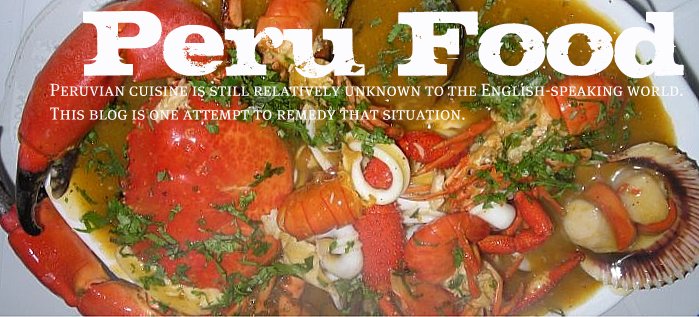The name, Orcotuna, is food-related. In Quechua, the Andean language spoken in the region, orco means place and tuna means the fruit of the cactus, or prickly pear, so Orcotuna means 'the place where the prickly pears grow'.
Soon thereafter, I started up at least two or three other blogs, but it was this one you are reading, Peru Food, that has gained the widest audience. I thank all of you for your interest.
My other blogs have been left by the wayside.
I am humbled. I never expected this blog, birthed by a Peruvian-American filled with nostalgia for the flavors, sounds, and textures of Peru, to be of interest to so many.
My own passion for Peruvian food, or for the nexus between food and culture and (dare I say it?) love, comes from my grandmother's kitchen and those annual trips to Orcotuna, to celebrate this feast day.
There was much food to be had during this time of year. Orcotuna is famous for its lechón asado, roast suckling pig, roasted over traditional wood fires.
But, it was pachamanca that ruled the day, that millenial Andean cooking style, where the food is cooked deep in the ground, within the embrace of the Pachamama, the Andean Earth Mother.
In keeping with the culinary vein of this blog, my next post will be a a recipe for pachamanca, but please indulge me with this re-post of my first blog entry ever.
¡Feliz 8 de septiembre!
Alejandro
From LAX - LIM, September 8, 2005.
Too many good things happened to me today, and yet it wasn't until almost the end of the day that I realized the significance of this date.
Today, 8 de septiembre, is the feast day of the patroness of my grandfather's Andean village, Orcotuna, my ancestral homeland.
I suddenly realized that in Orcotuna, today would be a day of processions, ritual dancing, eating, and drinking. A small image of a white Virgin would be paraded along the dusty streets, followed by chonguinada dancers dressed in elaborate 16th century costumes.
Musicians with violins and archaic harps would parade around the plaza playing syncopated huaynos, and encouraging the throngs of visitors to dance.
Vendors set up stands around the plaza, selling food and drink (since copious ingestion of beer and chicha and aguardiente are part and parcel of Andean festivities).
Four years ago, I went to Orcotuna to witness the event for the first time since my childhood, when I was dragged religiously on a yearly basis. Although my grandfather's reality had far removed him, in consciousness and experience, from the village life, the yearly visits to Orcotuna on 8 de septiembre were his way of linking his present with his past.
It had taken me over twenty years to make that same journey, and although I had been to many parts of the world, there was something that had kept me from returning to the one place where I can say: My people come from here.
Atop a hill, overlooking the red tiled roofs of Orcotuna, is the shrine that becomes the focal point on the ocho de septiembre.
It is built around a cave where apparently the Virgin first appeared, and as I trudged up the dirt road with all the other pilgrims, revelers, and tourists, I saw myriad Indian women, dressed in their many-layered skirts, kneeling before the cave entrance.
Their offerings were white candles they held in their hands oblivious to the wax dripping slowly on their bronze-colored skin. They prayed and chanted, their long braids bobbing, their heads covered by high-brim white hats.
It was being seven years old again. It was having my grandparents still alive, holding my small hands in theirs.
And as I looked into the cave, I realized that worshippers had imbued special meaning to a unique rock outcropping right inside the cave walls.
And it all made sense. Because in animist Andean cosmology, the mountains, the glaciers, rocks, and all manifestations of Nature, possess their own spirts.
Despite 500 plus years of Spanish post-colonialism and the unique synchretic reality that has since arisen, in Orcotuna, as in many other parts of the Andean world, there is still a link to that millenial past.
Suddenly I realized that I belonged there, that despite the vicissitudes of my own life and space and time, I too had a link to that ancient past.
Although the cultural landscape I best understand is the chaotic fractured polyglot post-modern megalopolis I call home, on that 8 de septiembre in Orcotuna, I could say:
My people come from here. And I too am from here.
Peru.Food@gmail.com
.
.
.
Click here for the Peru Food main page.
TAGS: Peru, Peruvian, food, cooking, cuisine, cocina, comida, gastronomía, peruana
TAGS: Peru, Peruvian, food, cooking, cuisine, cocina, comida, gastronomía, peruana

4 comments:
Bueno, sigue adelante! Ves como el tiempo pasa rápido ? :)
Saludos desde Panamá!
Gracias Elena y Melissa, me alegro mucho verlas por aca.
Abrazos,
Alejandro
.
.
.
Alejandro, that's absolutely beautiful ... not many people get to know or even care to know that they are linked to such deep roots and tradition, or they just view it in a casual way, as though it's not really a part of who they are. You're really lucky have these experiences, and to have the intelligence to recognize how important they are. Food for the soul, you could say. :-)
Carol,
Thank you for your kind words, you really made my day!
Alejandro
Post a Comment